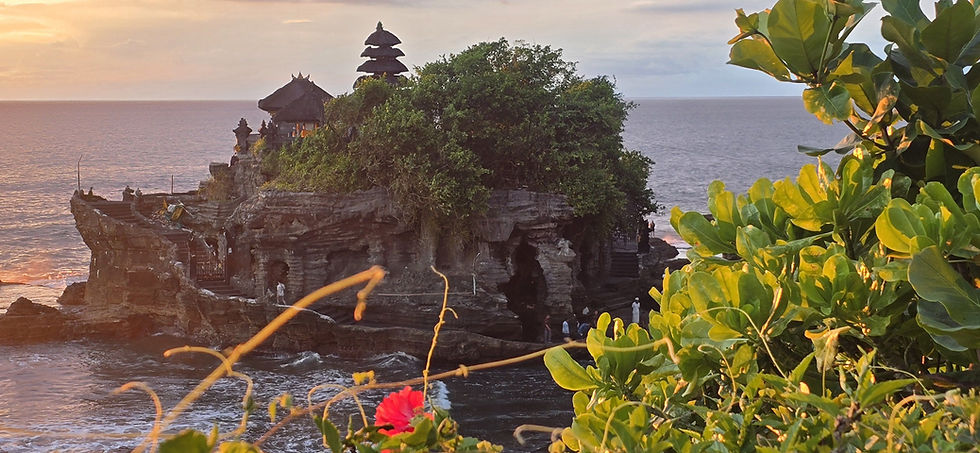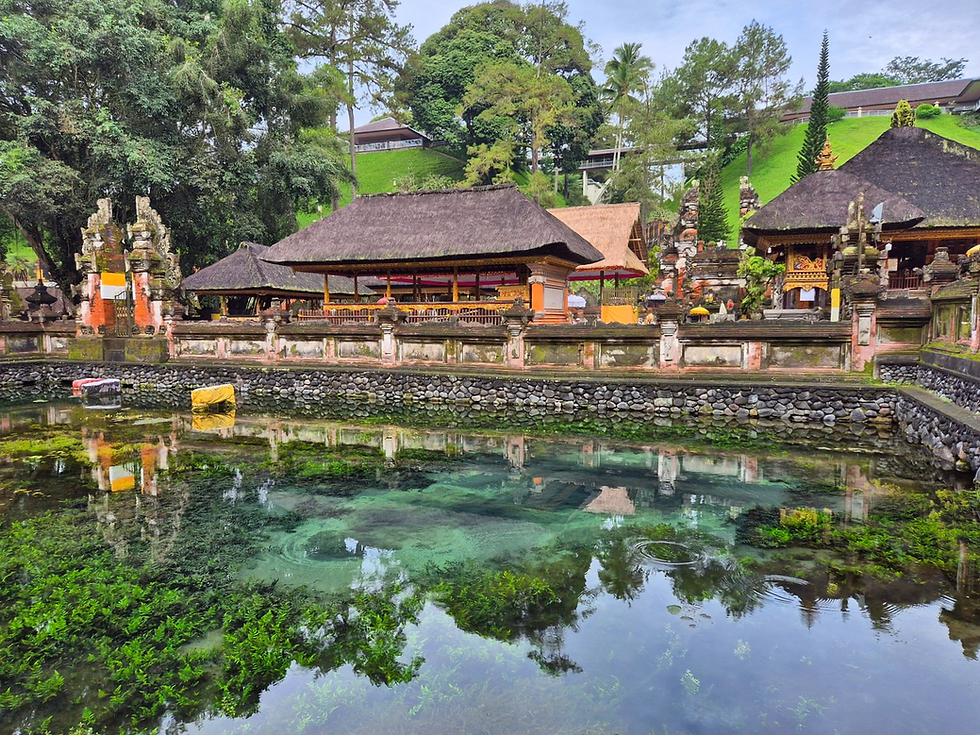Tanah Lot - Bali’s Famous Sea Temple
- Shannon
- Sep 19
- 4 min read
The Sacred Role of Tanah Lot in Balinese Hinduism
Tanah Lot, which translates to “Floating Land,” is one of Bali’s most revered and iconic sea temples. Located in the village of Beraban on the island’s rugged west coast, the spiritual outpost is perched atop an offshore rock formation about 300 metres from the beach, facing the relentless tides of the Indian Ocean. Though serene in appearance, the temple marks a threshold where gods are honoured and darker entities are held at bay. Established in the 15th century by the wandering Hindu priest Dang Hyang Nirartha, the temple was consecrated to the sea god Baruna.

According to legend, when Nirartha arrived in the area to spread the teachings of Hinduism, he found great resistance from the local village chief, who accused him of disturbing the spiritual order. In a show of divine power, Nirartha is said to have shifted an enormous boulder out to sea and created the temple upon it. To protect it, he transformed his sashes into venomous, protective sea snakes. These snakes, believed to dwell in the caves around the temple, are still regarded as sacred guardians and disturbing them is believed to bring severe misfortune. Some locals say the snakes only strike those with impure hearts, yet some elders claim the snakes were not guardians, but jailers, keeping a sea demon sealed in the caves below.
Tanah Lot is one of seven sea temples positioned along Bali’s southwestern coastline, each constructed within line of sight of the next, to form a sacred chain of protection against disruptive forces from the ocean. This coastal alignment is not just architectural, it embodies the Balinese philosophy of Rwa Bhineda, the belief in balance between opposing forces. Temples like Tanah Lot serve as spiritual fortresses, maintaining harmony between the land, sea and unseen realms through regular offerings and ritual practices. Historically, this spiritual defense was believed to require more than daily devotion. During the darkest phases of the lunar calendar, secret ceremonies were reportedly held to appease volatile sea spirits. These rites included symbolic immolations, the burning of effigies or the sacrifice of chickens or ducks made during times of great upheaval, such as shipwrecks or volcanic eruptions, when the island’s spiritual equilibrium was thought to be in jeopardy.

Sunset views at Tanah Lot - Bali’s Famous Sea Temple, perched on the rocky coast
One of the most remarkable features of Tanah Lot is the Tirta Pabersihan spring, a freshwater source that flows inexplicably from beneath the sea washed rock at the temple’s base. Despite being surrounded by saltwater, the spring produces clean, drinkable water and is considered sacred by the Balinese. Priests draw from it to perform ritual blessings, sprinkling visitors with the holy water as a form of purification. While the spring is often regarded as a divine anomaly, an affirmation of the temple’s sanctity, local belief adds a deeper layer of meaning. Some say the water carries a dual nature. It blesses those who come with pure intent but turns harsh toward those whose hearts are impure. For the Balinese, this spring is more than a curiosity, it is the spiritual threshold of the temple, marking a boundary between the everyday world and the sacred. Tourists may come for the view, but many locals approach it with quiet reverence, knowing that Tanah Lot is not just a place of beauty but of balance, protection and spiritual watchfulness.

Walking the causeway to Tanah Lot is to step into a liminal space where natural beauty and spiritual presence merge. The temple’s timeless allure, the breathtaking sunsets that ignite the sky, the scent of frangipani carried on the ocean breeze and the dramatic tides that isolate it at high water, draw visitors from around the world. Yet beyond its striking visuals, Tanah Lot remains a living temple deeply woven into the religious fabric of Bali. It is far more than a tourist destination, it is a spiritual fortress and ancient seal where rituals, legends and daily devotion continue uninterrupted. Many believe the gods still walk its shores alongside whispers of ancient chants carried on the salt air. Whether you come seeking faith, curiosity or simply a stunning photograph, it is impossible to leave untouched by the temple’s mysterious and powerful presence as the sun sets behind it, casting the shrine in silhouette against the burning sky.
🗺️ Location
Desa Beraban, Kecamatan Kediri, Kabupaten Tabanan, Bali, Indonesia
🚆 How to get there
Tanah Lot is located about 20 kms north of Kuta The cheapest means to get there is with a go-gek rider which costs about 250,000rp for a return trip. To reach the temple once you arrive, make your way down the walkway that runs from the vast parking lot through a sideshow of souvenir shops down to the sea. You can't miss it.
⭐ Attraction Info
Entry tickets cost 75,000 IDR for adults and 40,000 IDR for children. At low tide, you can walk over to the temple itself but foreigners are not allowed to go inside. This is an extremely popular tourist destination and the whole area is often busy, especially in the late afternoons, in preparation for sunset. The Tanah Lot Sun Terrace is located to the left hand side and offers a sweeping panorama, with plenty of cafe's and restaurant options.
🔗Official Website
Thanks for reading about Tanah Lot - Bali’s Famous Sea Temple. Check out more awesome destinations here!




























